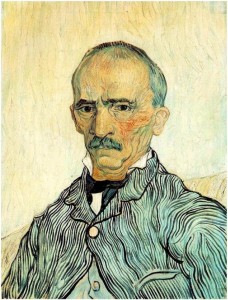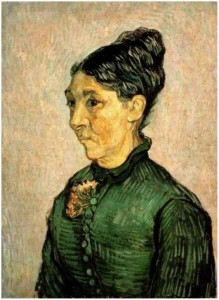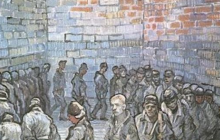While at the asylum in Saint-Remy, Vincent van Gogh painted a few portraits. One of the portraits is of Francois Trabuc, the chief orderly, or overseer, at Saint-Paul. On September 5th or 6th of 1889 Van Gogh wrote to his brother about the portrait and Trabuc, who Van Gogh found to have an interesting look,
“Yesterday I began the portrait of the chief attendant, and I may do his wife as well, since he is married and lives in a little farmhouse a stone’s throw from the institution.
A most interesting face. There’s a beautiful etching by Legros of an old Spanish grandee – if you remember it, it will give you an idea of the type.
He was at the hospital in Marseilles during two cholera epidemics, in short, he is a man who has seen an enormous amount of suffering and death, and he has an indefinable expression of quiet contemplation, so that I am irresistibly reminded of Guizot’s face – for there is something of that in his head, if different. But he is a man of the people and simpler. Anyway, you will see it if I succeed in doing it and if I make a copy of it.”
This original portrait by Van Gogh is most likely not the one we are familiar with but is instead a copy that Van Gogh made for his brother, the original being lost. On September 7 or 8, Van Gogh wrote to his brother about the copy of the portrait of Trabuc,
“I’ve done the portrait of the attendant [Lost painting] and have got a copy of it for you……he has a military air and small, lively, black eyes.”
“I have given it to him, and I’ll do his wife as well, if she wants to pose.”

Not much information is available about François Trabuc’s wife. Her name was Jeanne Lafuye Trabuc (1834-1903), and she was 55 years old when Van Gogh painted her portrait. Van Gogh described Madame Trabuc in the September 7th letter to Theo,
“She is a woman whose looks have faded, a poor soul, resigned to her fate, nothing out of the ordinary and so insignificant that I simply long to paint that dusty blade of grass. I talked to her sometimes when I was doing some olive trees behind their little house, and she told me then that she didn’t believe I was ill – in fact, you would now say the same if you saw me working, my mind clear and my fingers so sure that I drew that Pieta by Delacroix without taking a single measurement, though there are those four hands and arms in the foreground – gestures and postures that are not exactly easy or simple.”
Upon completing the painting of Jeanne, Van Gogh wrote to his sister, Wilhelmina, on September 19, 1889 saying,
“The other day I finished the portrait of a woman upward of forty years old, an insignificant woman. The withered face is tired, pockmarked – a sunburned, olive-coloured complexion, black hair. A faded black dress relieved by a geranium of a delicate pink, and the background in a neutral tone, between pink and green.”

He also wrote to Theo the same day and mentioned the painting,
“I have done a woman’s portrait – the attendant’s wife – which I think you would like.”
…..
“I have done a duplicate of it which is less good than the one from life. And I am afraid they will take the latter; I should have liked you to have it. It is pink and black.”
A third letter was written on September 19, 1889, this one to his parents expressing his fondness of portrait painting,
“As often as I have the chance, I work at portraits, which I myself sometimes think are better and more serious than the rest of my work. And if it might happen that my condition allows me to go back to Paris or its vicinity, that will probably be the important thing for me.”
Letter Source:
http://www.webexhibits.org/vangogh/letter/20/604.htm
http://www.webexhibits.org/vangogh/letter/20/605.htm
http://www.webexhibits.org/vangogh/letter/20/W14.htm
http://www.webexhibits.org/vangogh/letter/20/607.htm
http://www.webexhibits.org/vangogh/letter/20/606.htm



The portrait showed by artist, its all about imagination and love towards paintings. His feeling connect with audience with emotion. Thank for updating….